
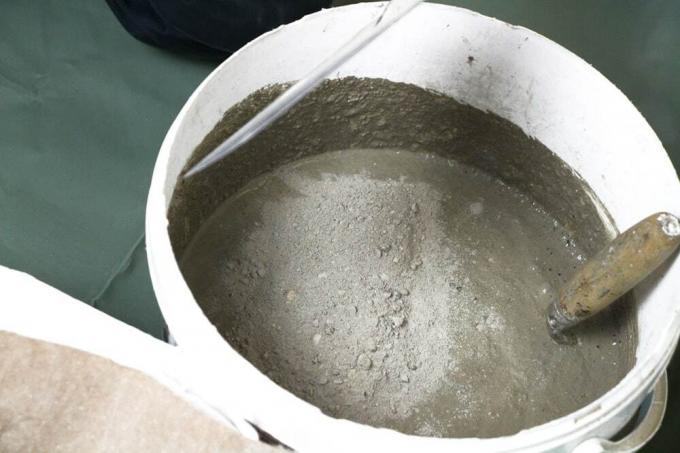
Table of contents
- types of concrete
- insulating concrete
- fiber concrete
- Easily workable concrete (LVB)
- Translucent concrete
- normal concrete
- recycled concrete
- spun concrete
- Self Compacting Concrete (SCC)
- exposed concrete
- prestressed concrete
- stamped concrete
- concrete classes
- compressive strength class
- exposure class
- consistency class
- aggregate
- bulk density
- Typical designations
The types of concrete are as versatile as its use as a modern building material. Divided into classes, the right concrete is available for every application. We explain what types and classes there are.
types of concrete
Where concrete in its early days more than two thousand years ago was "only" a homogeneous substitute that was easy to produce on site for stone, today the building material convinces with its enormous specialization in the most varied of uses. Depending on the requirements, the composition and nature can vary greatly.
insulating concrete
Traditionally, concrete generates its enormous resilience through a high density of around 2.0 to 2.5 kg/dm3. This is accompanied by extremely poor insulating properties. In order to make the use of additional insulating materials obsolete, insulating concrete also has acceptable insulating values.
- Task: Production of load-bearing components with an insulating effect
- Special feature: Additives such as natural pumice, expanded clay or foam glass as air-entraining agents
- Examples of use: Components or buildings with a concrete look with requirements for thermal insulation
fiber concrete
As an alternative to the well-known reinforcement steel fiber concrete different fibers are introduced to increase the resilience.
- Task: high load-bearing capacity with small component dimensions
- Special feature: Glass fibres, textile fibers or, rarely, metal fibers as a substitute for reinforcing steel
- Examples of use: slim components, such as facing shells, furniture or garden objects, etc.
A NOTICE:
Normally, depending on the intended use, concrete must have a certain concrete cover over built-in steel to protect against corrosion. In the case of non-metallic fibers, the overlap can be significantly less and the component dimensions can therefore be significantly reduced.
Easily workable concrete (LVB)
With regard to the grain size and additives used, LVB is designed to be processed as uniformly as possible and without damage. It meets both technical and optical high requirements with a simple installation
- Task: Simple installation in narrow, complicated formwork with dense reinforcement without defects, gravel nests, etc.
- Special feature: Maximum grain size usually 8 to 16 millimeters, often with the addition of superplasticizers and setting retarders
- Examples of use: Exposed concrete components, slender columns or beams
Translucent concrete
True, there is no real "transparent" concrete. However, it is possible to make it translucent for special effects.
- Task: Transport of light through the concrete component as an effect or for basic brightness
- Special feature: layered glass fiber mats or bundles as light channels
- Examples of use: Art installations, public buildings, museum and sacred buildings
DANGER:
The incorporation of glass fibers into the concrete limits the use of reinforcing steel. The more light transmission is desired, the more the load-bearing capacity of the component is restricted.
normal concrete
The most commonly used type of concrete is normal concrete. One always speaks of normal concrete when the basic mixture is not affected by aggregates, fixtures, etc. is modified to a special type of concrete.
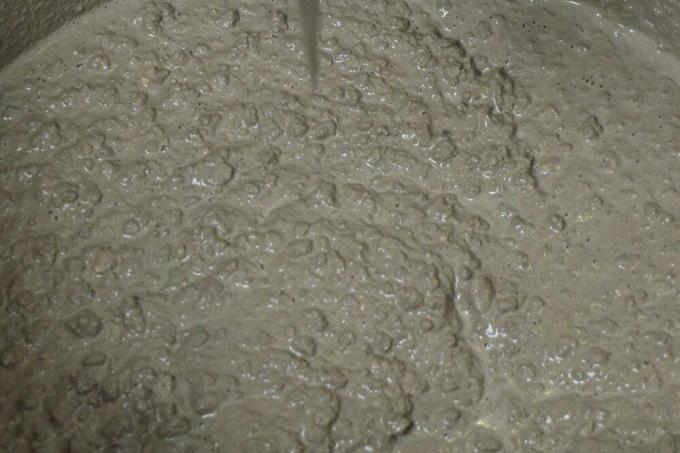
- Task: Production of normal loadable concrete components without special requirements
- Special feature: Mass i.d. R between 2.0 and 2.5 kg/dm3, compressive strength 5.0 to 55.0 N//mm2, hardening to standard strength according to DIN after 28 days
- Examples of use: Walls, ceilings, foundations etc.
recycled concrete
Recycled concrete picks up on the trend towards more sustainability and, depending on the desired properties, replaces parts of the mineral aggregates with recycled construction waste. Aggregate properties such as grain size, grading curve, load capacity, etc. are retained and taken into account unchanged.
- Task: Reducing the consumption of finite resources
- Special feature: processed building rubble as a substitute for mineral additives (sand, gravel, grit)
- Examples of use: depending on the concrete class as types of concrete without recycled building materials
spun concrete
Spun concrete describes the production of axially symmetrical linear components such as posts, masts, tubes, etc. in rotating molds.
- Task: Highly compacted, thin-walled components with high resilience through the use of centrifugal force
- Special feature: heavily layered structure due to ingredients of different weights in the centrifuge
- Examples of use: Power poles, concrete pipes etc.
Self Compacting Concrete (SCC)
Poor compaction often leads to optical and technical defects in the concrete component due to difficult access to the formwork or extremely dense reinforcement. Self-compacting concrete, on the other hand, does not require mechanical compaction by shaking or tamping.
- Task: Avoidance of defects, gravel nests, etc. in tight formwork
- Special feature: high level of uniformity without mechanical compaction methods thanks to the strong addition of superplasticizers and setting retarders
- Examples of use: Exposed concrete components, filigree components such as columns and beams, bridges, etc.
exposed concrete
For some time now, many designers have deliberately used concrete as a visible surface. A surface without air bubbles or gravel nests is important for a high-quality look.
- Task: high quality optical surface
- Special feature: Heavy use of flow agents, sometimes colored additives to change the look
- Examples of use: Buildings with an exposed concrete look, engineering structures such as bridges, retaining walls, underpasses, etc.
prestressed concrete
The load-bearing capacity of normal reinforced concrete can be further increased if the entire component is tensioned from the start in the opposite direction to the subsequent load. One then speaks of so-called prestressed concrete
- Task: Increase in resilience
- Special feature: Installation of tensioning wires, tensioning cables or tensioning rods, which are technically tensioned after the concrete has hardened (mainly by screwing)
- Examples of use: Industrial buildings, traffic structures (bridges!)
stamped concrete
Without reinforcement and compacted only by mechanical shocks, stamped concrete is the oldest type of concrete. It is often found in existing buildings in particular, for example on foundations or massive bridge piers.
- Task: Absorption of pressure loads, often in foundation components
- Special feature: no reinforcement, layered installation and compaction by tamping
- Examples of use: formerly for all concrete components, today still occasionally in horticulture as foundations and for other subordinate components
concrete classes
In order to find exactly the desired or To obtain the concrete required for a task, there are a number of different classifications today. Each classification considers a different property. As a result, today's technical designations for a specific concrete can include a whole range of different specifications. Typical is the classification according to:
compressive strength class
The decisive factor for the load-bearing capacity of concrete is the pressure it can withstand when it has set. Typical designations are a "C" for "Concrete" and two numbers separated by a slash. The first (smaller) number indicates the load in N/mm2 for a cylindrical specimen, the second number for a cube-shaped specimen. Common compressive strength classes are:
- C8/10 (eg. B. with lean concrete for minor soil improvements, in horticulture, etc.)
- C12/15
- C16/20
- C20/25
- C25/30 (common for many types of normal concrete, e.g. B. in classic house construction)
- C30/37 (from this class usually can only be produced with special technical equipment)
- C35/45
- C40/50
- C50/60
- C55/67
etc. - C90/105 (from here on no more general approval available, therefore approval required in each individual case, production technically only possible as spun concrete)
- C100/115
exposure class
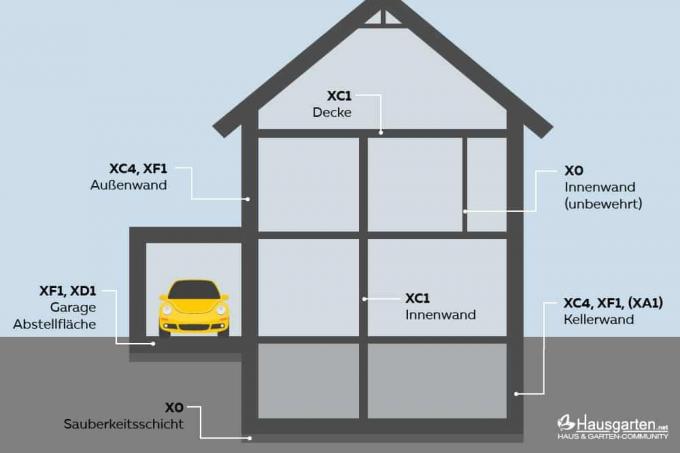
Depending on how much a concrete component is exposed to environmental influences, it must be able to offer long-term resistance to these influences. For this purpose, concrete is divided into different exposure classes:
- X0: Unreinforced concrete and foundations without frost, no risk of attack for concrete and / or reinforcement
- XC (1-4): Interior or foundation components with high humidity (swimming pool, stables, laundries, etc.), open structures
- XD (1-4): Components in the spray mist area of traffic areas, roadways, brine baths
- XS (1-3): External components near the coast, as well as port facilities, quay walls, etc.
- XF (1-4): Traffic areas treated with de-icing agents, seawater components, scraper runways
- XA (1-3): Components exposed to chemical attack, such as tanks in sewage treatment plants, liquid manure tanks, silage silos
- XM (1-3): Wear stress, e.g. E.g.: for industrial floors
In addition, four quality classes W0, FW, FA and WS designate the concrete quality for components exposed to moisture.
consistency class
Depending on the application, concrete with certain flow or stability properties may be necessary:
- C0: Very stiff, not DIN EN206
- F1: stiff
- F2: plastic
- F3: soft
- F4: very soft
- F5: flowable
- F6: very flowable
- F6*: SCC (self-compacting)
aggregate
Depending on the requirements, differently sized aggregates can be used for the concrete. A distinction is made between sand concrete, gravel concrete and crushed concrete. The grain size used is specified with the maximum diameter (Dmax).
bulk density
Depending on the density of the concrete, it is divided into three categories.
- lightweight concrete
- normal concrete
- heavy concrete
Each of these categories is further divided into raw density classes by DDIN EN206, from which the raw density results. For lightweight concrete, for example, there are 6 bulk density classes D1.0 to D2.0, with D2.0 meaning a bulk density of between 1,800 and 2,000 kilograms per cubic meter of concrete. The bulk density of a concrete is important for the self-weight of a component, but also, for example, for the definition of a surcharge by a concrete component.
Typical designations
A specific concrete mixture does not always have to be classified in all available classes. Sometimes it is also sufficient to determine, for example, the load and the exposure class, while density and grain size are irrelevant for the intended use. A typical concrete for foundation components, such as foundations, floor slabs, etc. is therefore about:
C25/30 XC1
This is a typical normal concrete with a medium load capacity and a low Resistance to moisture, such as that found in normal components in contact with the ground without oppressive groundwater etc can be used.
 Home editorial office
Home editorial office
Learn more about concrete, screed and cement
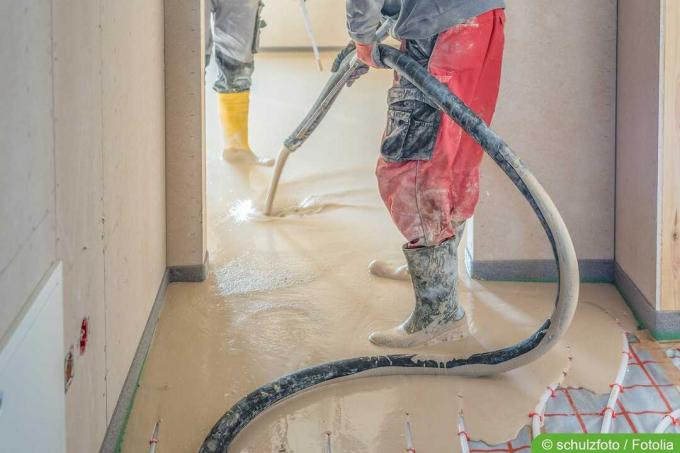
Fresh screed: when can it be walked on?
Screed is the basis for many floor coverings. It is durable and easy to care for. However, if the load is applied too quickly after application, it can be damaged, with costly consequences. We show how long the drying time is.

What is fiber concrete? | Features & Best Practices
What is fiber concrete? This term describes special concretes that are mixed with different fibers. They expand the possible uses in many ways and have an effective effect on the stability and durability of the concrete.

What is trass cement? | The differences to cement
Trass cement describes a special type of cement with corresponding amounts of trass. The additive makes the mortar mixed from it more resistant and is effectively suitable for certain areas of application. In this guide you will find out how the mixture differs from conventional cement mixtures.

What is flow concrete | Properties & Applications
As the name suggests, flowable concrete is a much more fluid mass than conventional concrete. This is made possible by adding a flow agent. You can find out about the properties and areas of application of concrete in this guide.

How much does a cubic meter of concrete cost? | precast concrete prices
The independent production of concrete is done in a few simple steps thanks to ready-mixes from the hardware store. The so-called ready-mixed concrete consists of various components and is available in different variants depending on the intended use. The price per cubic meter depends on several factors.
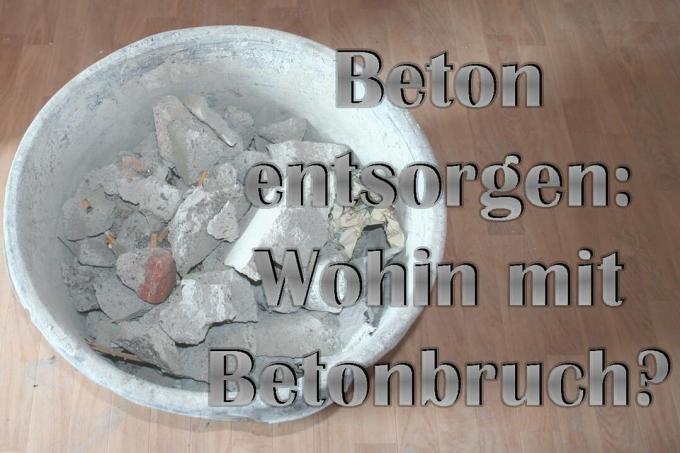
Disposing of concrete: what to do with broken concrete?
Broken concrete often occurs during conversion or demolition work. It is clear that the chunks do not belong in the normal household waste. However, this raises the question of whether concrete is building rubble, construction waste or even hazardous waste.
